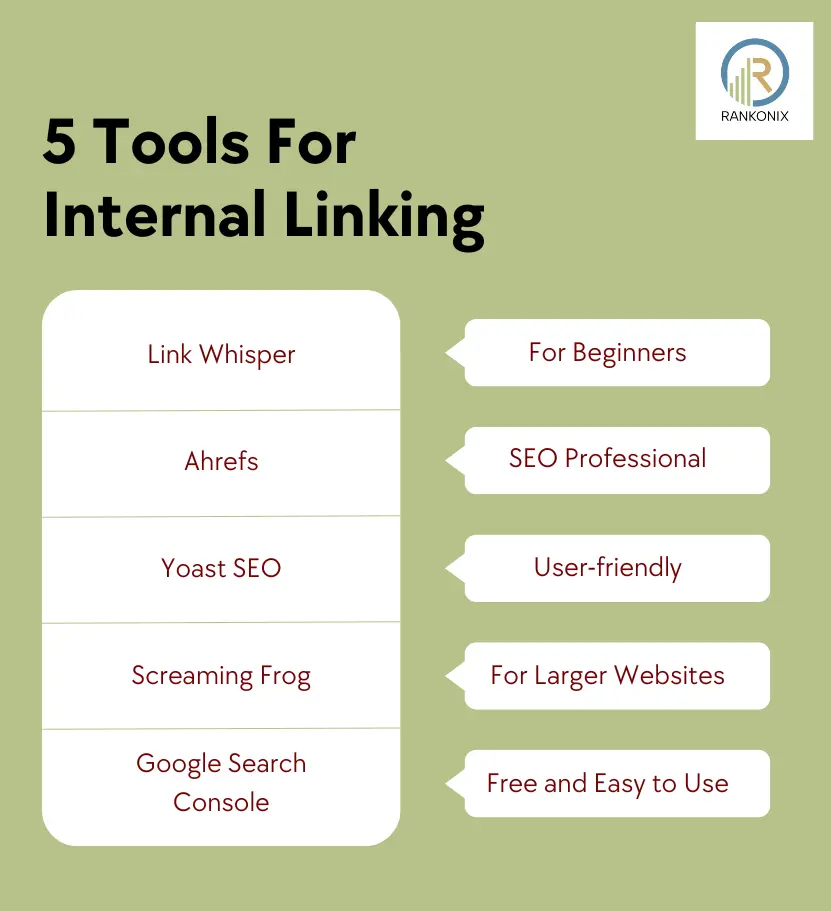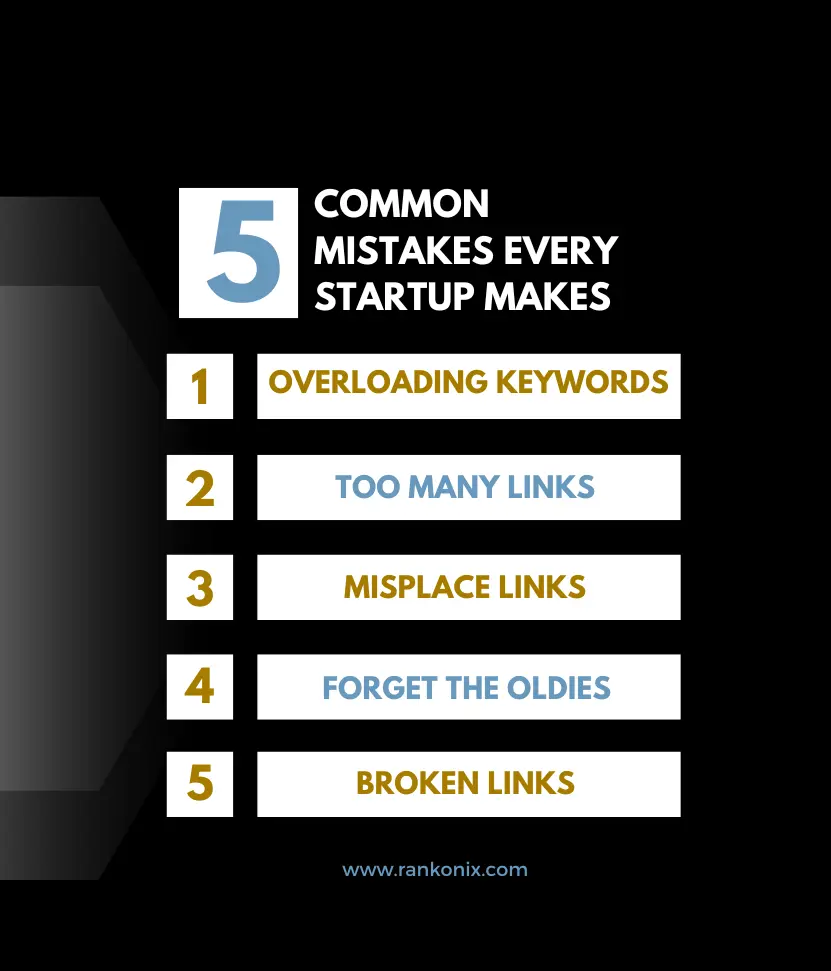Table of Content
- What is Internal Linking for SEO
- How Many Internal Links are Ideal for Good SEO
- 20 Main Types of Internal Linking and Their Functions
- Internal Linking Best Practices: Simple Steps to Optimize Your Links
- Advanced Internal Linking Strategies: Effective Ways to Increase Page Authority and Engagement
- How to Do Best Internal Linking for SEO
- 5 Best Tools for Internal Linking Optimization
- Common Mistakes to Avoid in Internal Linking for SEO
- Conclusion
- FAQs
Picture this: you’ve poured hours of effort into crafting amazing content, yet visitors leave your site within seconds. Why? They’re either not finding what they’re looking for—or they don’t realize what else your site has to offer. This is a common challenge, often stemming from weak or missing internal links. But here’s the good news: it’s fixable.
In this guide, we’ll explore the essentials of best internal linking for SEO. You’ll discover how effective internal links can seamlessly guide users, boost engagement, and elevate your rankings. From avoiding common pitfalls to mastering advanced strategies, you’ll gain the tools to keep visitors on your site longer and ensure search engines recognize your most valuable pages. Let’s get started.
What is Internal Linking for SEO
Internal linking for SEO is like building a roadmap within your website. Think of it as guiding visitors through a museum, where each link directs them to the next fascinating exhibit, encouraging them to discover more of your content.
Simply put, an internal link connects one page of your website to another on the same site. This practice not only enhances navigation but also improves your website’s structure, making it easier for search engines to crawl and boosting your visibility in search results.
How Many Internal Links are Ideal for Good SEO
The ideal number of internal links for good SEO depends on the length of your content:
- Shorter pages (500–700 words): Include 3–5 internal links to keep it concise and relevant without overwhelming readers.
- Longer pages (1,500+ words): Aim for up to 10 links or more, as the additional content provides more opportunities for meaningful connections.
- Content-heavy pages (2,500+ words): Use 10–15 links or more, as long as they integrate naturally and add value.
The key to effective internal linking for SEO is ensuring each link is relevant, useful, and seamlessly fits the context. Too many links can clutter the page, so focus on connecting to valuable, related content to enhance the reader’s experience.
20 Main Types of Internal Linking and Their Functions
There isn’t a universally defined number of internal link types, as these can vary depending on a website’s structure, purpose, and design. However, based on common practices, there are approximately 20 key types of internal links commonly used across different websites. Here are the 20 main types of internal links for all types of content and their functions:
| Type of Internal Link | Description |
| Navigation Links | Links in the main menu, header, or footer that guide users to key pages. |
| Contextual Links | Links within the content (e.g., in articles) that direct readers to related pages. |
| Footer Links | Links in the footer that provide extra navigation to important sections of the site. |
| Image Links | Clickable images that link to other pages to make navigation visually engaging. |
| Sidebar Links | Links in the sidebar, often showing related posts or categories. |
| Breadcrumb Links | Path links (e.g., Home > Category > Page) that help users see site structure and navigate back. |
| Related Post Links | Links to similar content, often shown at the end of a post to encourage further reading. |
| Category Links | Links to specific content categories like “Blog” or “Products” to help users find grouped topics. |
| Tag Links | Links based on specific tags or keywords (e.g., “SEO”) to group similar content. |
| Anchor Links (Jump Links) | Links to specific sections within the same page, often used in tables of contents. |
| Product Links | Links between related or recommended products, typically in e-commerce sites. |
| Author Links | Links to an author’s profile, often showing more articles by the same writer. |
| Event or Special Content Links | Links to seasonal or special content (e.g., promotions or events). |
| Call-to-Action (CTA) Links | Links in CTAs (e.g., “Read More” or “Sign Up”) that encourage specific actions. |
| Table of Contents Links | Links in a table of contents at the top of a long page, helping users jump to sections. |
| “Recently Viewed” Links | Links to pages that users recently viewed, helping them quickly revisit content. |
| “Most Popular” Links | Links to the most popular or top-performing pages, products, or posts on the site. |
| FAQ Links | Links within a FAQ section that direct users to detailed answers or related pages. |
| Site Map Links | Links on an HTML sitemap page that provide an overview of all site pages. |
| Timeline Links | Links in timeline content (e.g., “Our Story”) that lead to different events or points in time. |
This table provides a quick overview of each link type and its function, helping you understand how they contribute to a better user experience and improved SEO.
Internal Linking Best Practices: Simple Steps to Optimize Your Links
Enhance your SEO and improve user experience with these internal linking best practices. Follow these tips to effectively connect pages on your website and boost its overall performance.
1. Use Clear and Descriptive Anchor Text
Anchor text should naturally describe the linked content, incorporating relevant keywords to provide context for both users and search engines. This makes navigation intuitive and enhances SEO. Avoid generic phrases like “click here,” which offer no clarity. Instead, opt for descriptive text like “Learn SEO Basics” or “Best Blogging Tips” to guide readers effectively.
2. Link to Relevant and High-Quality Content
Ensure the pages you link to are directly related to the topic at hand and offer value to readers. For instance, if you’re writing about SEO strategies, link to pages covering SEO tools or keyword research. Regularly check your links to avoid broken or outdated pages that can damage user trust and harm your SEO performance.
3. Keep Links Balanced and Purposeful
Avoid cluttering a page with excessive links, as it can overwhelm readers and dilute their usefulness. Aim for 5–10 links per page, depending on the length and depth of your content. Each link should serve a clear purpose, seamlessly directing users to relevant information without overburdening them.
4. Prioritize Your Key Pages
Identify the most important pages on your site, such as flagship blog posts, core services, or key product pages, and link to them frequently. This not only helps guide users to high-value content but also signals to search engines that these pages are authoritative and significant, improving their visibility.
5. Place Links Strategically
Position links where they’ll naturally catch the reader’s eye, such as in the introduction, conclusion, or as part of a call-to-action. Thoughtful link placement increases click-through rates, encourages engagement, and smoothly directs users to other valuable parts of your website.
6. Build a Logical Link Structure
Organize your internal links to create a coherent structure that helps users and search engines navigate your site effortlessly. Think of it as a branching tree: main pages connect to subtopics, creating a clear, hierarchical flow that enhances the user journey while improving content discoverability.
By applying these internal linking best practices, you can create a seamless internal linking for SEO that not only improves SEO rankings but also elevates the overall user experience on your website.
Advanced Internal Linking Strategies: Effective Ways to Increase Page Authority and Engagement
These internal linking strategies will help you build a well-structured, SEO-friendly website that’s easy to navigate.
1. Build Content Hubs and Clusters
Organize related content around a central “pillar” page. For example, if you have a main page on “SEO Basics,” link supporting pages, like “Keyword Research” or “SEO Tools,” to and from it. This method enhances website organization, strengthens topic authority, and boosts overall SEO performance.
2. Establish a Clear Hierarchical Structure
Design your site with a logical structure. Main pages, such as a “Services” page, should link to subpages like individual service details. This hierarchy not only helps users find what they need but also signals search engines which pages hold the most importance.
3. Refresh Old Content with New Links
Update older posts by adding links to your latest content. This keeps older pages relevant, enhances their value for users, and helps search engines quickly discover new pages. It’s a simple yet effective way to improve SEO across your site.
4. Use Descriptive Anchor Text with Keywords
Incorporate relevant keywords naturally into your anchor text. For instance, when linking to a page about “SEO Tips for Beginners,” use those words directly in the link. This provides context for search engines while keeping the experience seamless for readers.
5. Avoid Link Overload or Irrelevant Links
Only include links where they genuinely add value. Overusing links or forcing irrelevant ones can appear spammy and may harm your SEO. Prioritize links that guide users to useful, related content.
6. Monitor and Optimize Link Performance
Leverage tools like Google Analytics to track internal link performance. Identify which links drive the most clicks or encourage users to stay longer on your site. Use these insights to refine your strategy, improving both user experience and SEO outcomes.
By following these internal linking strategies, you can create a website that’s not only easier to explore but also optimized for search engine success.
How to Do Best Internal Linking for SEO

Here’s a step-by-step guide on how to do best internal linking for SEO effectively which will keeps your site up-to-date, build high-quality backlinks and helps improve SEO:
Step 1: Decide which blog post or page you want to add internal links to. This will be your “current page“.
Step 2: Identify other pages or posts on your site that cover similar or related topics. Look for pages that would naturally add value to your current page if linked.
Step 3: Select specific words or phrases to use as the clickable link (anchor text). For example, instead of using “click here,” use something specific like “beginner’s SEO guide” so that users and search engines know what the link is about.
Step 4: Insert the links to your chosen related pages in logical places within your content, such as:
- Introduction
- Near any relevant section that relates to the linked content
- Conclusion or near a call-to-action like “Learn more”
Step 5: Aim to add around 3-5 internal links per page to avoid overwhelming the reader.
Step 6: Linking to high-value pages helps boost their SEO ranking.
Step 7: After adding links, test each one to ensure it’s working correctly. This way, readers won’t encounter broken or incorrect links. Every few months, revisit older content to add links to any new relevant pages you’ve published.
By following these steps, you’ll create an organized and user-friendly structure for Internal linking optimization that benefits both SEO and the reader experience.
5 Best Tools for Internal Linking Optimization

Here’s a refined list of best SEO tools for internal linking optimization, rated according to their ease of use and effectiveness, which should help you understand each tool’s performance:
1. Link Whisper
- Performance Rating: ★★★★☆
- Best For: Beginners and WordPress users
- Pros: Simple to use, automatic link suggestions, and customizable settings.
- Cons: Only available for WordPress and may require a paid plan for advanced features.
2. Ahrefs
- Performance Rating: ★★★★★
- Best For: SEO professionals and large sites
- Pros: In-depth analysis, high accuracy, and powerful insights for SEO optimization.
- Cons: Can be costly, with a learning curve for beginners.
3. Yoast SEO (for WordPress)
- Performance Rating: ★★★★☆
- Best For: WordPress users focused on content optimization
- Pros: User-friendly, integrates well with WordPress, and good for basic internal linking.
- Cons: Limited to WordPress and offers fewer link analysis details compared to more specialized tools.
4. Screaming Frog
- Performance Rating: ★★★☆☆
- Best For: Technical audits on larger websites
- Pros: Excellent for detailed site crawls and broken link identification.
- Cons: Not beginner-friendly; requires setup and understanding of technical SEO.
5. Google Search Console
- Performance Rating: ★★★☆☆
- Best For: Beginners who want free insights
- Pros: Free, easy to use, and offers basic insights for internal link improvement.
- Cons: Limited to traffic and performance data; lacks advanced linking suggestions.
This performance-based rating should help you choose the tool that best fits for internal linking optimization and enhance level for best internal linking for SEO.
Common Mistakes to Avoid in Internal Linking for SEO

Avoid these common mistakes to keep your website user-friendly and improve internal linking optimization. Here’s what to watch out for:
- Keyword Overloading: Overusing keywords in anchor text can hurt your rankings.
- Excessive Links: Adding too many links can overwhelm users and dilute link value.
- Poor Link Placement: Misplaced links disrupt navigation and reduce their effectiveness.
- Neglecting Old Content: Failing to link to older, relevant pages misses opportunities to boost visibility.
- Broken or “Nofollow” Links: These links frustrate users and waste valuable SEO potential.
SEO evolves constantly, so it’s crucial to review your internal links regularly. Update them to reflect new content, fix broken links, and ensure they enhance navigation and coherence. By steering clear of these mistakes in internal linking for SEO, you’ll not only improve your site’s organization and usability but also strengthen your SEO for better rankings.
Conclusion
In the end, I would say that best internal linking for SEO is a crucial yet often underestimated aspect of SEO that can significantly impact your website’s performance. By implementing effective internal linking strategies and best practices, you can not only improve your search engine rankings but also enhance user engagement, encouraging visitors to explore more of your content.
If you found this article helpful, be sure to check out our other posts packed with actionable SEO insights to help your business thrive. At Rankonix, we know that success lies in the details, and we’re here to guide you through every step of your SEO journey.
Ready to elevate your website’s SEO? Contact Rankonix today for tailored solutions that boost rankings, drive traffic, and deliver tangible results. Together, we can create a website that attracts visitors, keeps them engaged, and converts them into loyal customers.
FAQs
Q: What is an internal link in HTML?
An internal link in HTML connects one page of a website to another page within the same site. These links are created using the <a> tag in HTML. The <a> tag includes the URL of the target page (via the href attribute) along with clickable text, known as anchor text, that describes the link’s purpose.
Q: How do you create internal links in HTML?
Here’s a simple step-by-step guide to creating an internal link in HTML:
- Choose the Target Page: Decide which page on your website you want to link to.
- Use the <a> Tag: Start by creating a link using the <a> tag in your HTML code.
- Add the href Attribute: Within the <a> tag, include href=”page-name.html” to specify the target page’s URL.
- Write Anchor Text: Between the <a> and </a> tags, write the clickable text users will see, such as “About Us.”
Q: How does internal linking for SEO differ from external linking?
Internal linking and external linking serve distinct purposes in website navigation and SEO optimization. Internal links connect pages within the same website, improving navigation, guiding users to key content, and boosting SEO by spreading link equity. External links, by contrast, direct users to pages on other websites, providing additional resources and enhancing credibility. Both are crucial for a better user experience and effective SEO strategy.










[…] benefits of HTTPS go beyond security. It boosts your website’s credibility, as browsers label HTTPS sites as “secure,” while non-HTTPS sites may appear as “not […]
[…] Use Internal Links to Improve […]
[…] Use internal links to connect your most important pages. […]